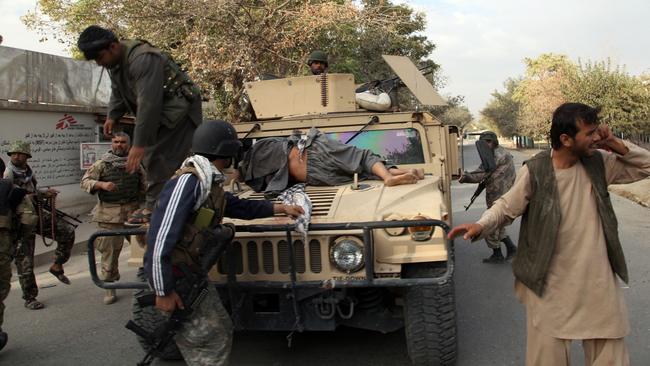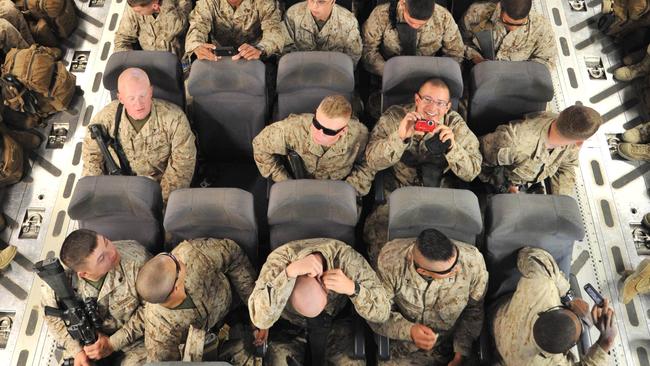
Two weeks ago the Taliban very nearly captured Tarin Kowt, capital of Oruzgan province in southeastern Afghanistan.
At dawn on September 5, well-armed guerillas assaulted the town’s outskirts, quickly overran the defences and forced provincial officials to flee to the airport. Police headquarters were besieged, 15 checkpoints were abandoned without a fight and hundreds of civilians were driven from their homes. Taliban fighters posted video of themselves looting and burning buildings, and searching house to house for government supporters. It took multiple airstrikes by US, NATO and Afghan warplanes to stave off a collapse.
Lieutenant General Abdul Raziq, police chief of neighbouring Kandahar province, led a column of Afghan National Police to Tarin Kowt to relieve the siege. Supported by the aircraft and fighting alongside army reinforcements hastily flown to the airstrip, they managed to push back the Taliban and clear most of the town. But by week’s end, after four days of fighting, Taliban fighters were counter-attacking — allegedly using civilians as human shields — and still held areas in the city’s outskirts.
Afghan spokesmen initially claimed heavy Taliban casualties, but later admitted government troops were exhausted, running out of ammunition and effectively encircled.
Raziq — who, though technically a provincial police chief, has such a fearsome reputation that his force informally has become Kabul’s rapid-reaction force across southern Afghanistan, rushing from crisis to crisis as needed — announced he planned to stay in Tarin Kowt until the town was stabilised.
But one Afghan officer told me with a shrug that he expected a fresh Taliban assault as soon as Raziq and his police left and the aircraft were diverted to the next battle.
Australia spent seven years and millions of dollars rebuilding Oruzgan. Forty-two Australian soldiers were killed and 261 wounded in Afghanistan, which at the height of our commitment was the fourth largest recipient of Australian aid in the world.
Less than three years after the Australians left, all but one of Oruzgan’s districts is Taliban-contested or controlled, and opium cultivation is booming. The 4th Brigade of the 205th Corps — the Afghan unit that was the focus of Australian mentoring from 2006 to 2013 — took little part in the defence of Tarin Kowt.
Oruzgan is no exception: Afghan forces are fighting simultaneous battles in 15 of Afghanistan’s 34 provinces. Whatever their bravery — and there are many courageous, competent soldiers and police in Afghanistan — the challenge is one of scale and simultaneity. There simply aren’t the resources to go around, or troops to defend every threatened point.
It’s two years this month since the agreement that brought to office Afghanistan’s present national unity government, and one year since the Taliban captured Kunduz, a key northern provincial capital and the first city to fall to the insurgents in the entire war to date. Afghan troops, assisted by US Special Forces, recaptured Kunduz after weeks of fighting.
But the situation has been looking increasingly shaky ever since, just as world attention has drifted elsewhere. And as the campaign against Islamic State has escalated in the Middle East, many of the same assets needed in Afghanistan are being diverted to Iraq and Syria, making this year’s campaign particularly precarious.
The crisis has been a long time coming. Each year since 2012, the last campaign season in which NATO and coalition troops carried the main combat burden against the Taliban, the insurgents have mounted an increasingly determined offensive.
Each year, as foreign forces have gradually withdrawn, Afghan forces have almost — not quite — held their own. But each year’s campaign has seen the government start from slightly further behind while suffering costs — in money, equipment, casualties and desertions — it can’t sustain in the long term.
In multiple interviews during the past several months with Afghan friends, officials and academics speaking by phone from Kabul, members of the international advisory mission, and expert observers elsewhere, four issues have consistently emerged to explain the decline. The first is political fragility in Kabul.
Political fragility
In September 2014, Hamid Karzai achieved the first non-violent handover between presidents in Afghan history, brokering a compromise between Ashraf Ghani (a former finance minister and World Bank official from the Pashtun ethnic group) and former foreign minister Abdullah, a veteran Northern Alliance commander and Tajik leader.
Abdullah had challenged Ghani in the 2014 presidential election; after Ghani won the vote, Abdullah’s allies disputed the outcome. In the event, the agreement gave Ghani the presidency while Abdullah took the new title of chief executive. This delicate compromise averted the immediate confrontation.
It also created the national unity government, letting NATO and its partners (including Australia) declare an end to combat operations in December 2014 and transition to the present “advise and assist” posture, the so-called “light footprint” approach, with far less expenditure and far fewer troops on the ground. But the agreement was for only two years. It expires on Monday and Afghanistan’s leaders have argued over it in recent weeks, with Abdullah publicly declaring Ghani “unfit to hold office”.
The quid pro quo for Abdullah’s acquiescence was to have been electoral reform, local elections, and a loya jirga (national assembly) to consider constitutional changes converting Abdullah into an executive prime minister. None of that happened: Abdullah claims he has been excluded from decision-making while Ghani delays elections, stacks government with proteges and fellow Pashtuns, and rules without parliamentary checks. Now Abdullah and his supporters — including governors and warlords such as Ismail Khan and Atta Mohammed Nur, as well as Amrullah Saleh, the powerful former head of Afghanistan’s intelligence service, the National Directorate of Security — want a more equitable deal.
Ghani’s centralising tendency, his attempts to monopolise power in the presidential palace and his lack of a personal support base within his own Pashtun community have made people question his motives, turning Abdullah’s followers into a broad political opposition, according to an Afghan friend who runs a well-regarded news service in Kabul and often speaks with Abdullah supporters. A senior Afghan security official, discussing the Tarin Kowt battle last week, agreed: in his view, lack of political cohesion at the centre of government makes it extremely hard to co-ordinate defences at the provincial and district level.
Different local officials, loyal to competing factions in Kabul, are unwilling to share information, pool their resources or co-operate tactically in the face of the rising insurgent threat.
This is a particularly acute problem when it comes to co-ordination among the three critical agencies of the Afghan security forces: the army, police and NDS. In Kunduz last year, a poisonous disagreement over local militias between the provincial governor (a Ghani appointee) and the chief of police (an Abdullah supporter) was a key factor in the loss of the town. Lack of army-police co-ordination also seems to have played a role in the near-disaster at Tarin Kowt.
For his part, responding to Abdullah’s criticisms, Ghani says security in the countryside simply hasn’t permitted elections or government reform. Whatever his motives, he’s not wrong about that — deteriorating provincial security is the second factor on which virtually all Afghans agree.
Insecurity in the provinces
The loss of Kunduz was a shock to the roughly 70 per cent of Afghans who support the government, and not just because it was the first city the insurgents had captured. Kunduz also carried a historical echo: it was the first provincial capital seized by the mujaheddin after the Soviets withdrew in 1989, beginning a period of chaos that led to civil war, spawned the Taliban, drew in al-Qa’ida and prompted foreign invasion after 9/11. So when the Taliban again seized Kunduz, nine months after the formal end of NATO’s combat mission, this sent a disturbing message to Afghans that history was repeating itself.
Likewise, the size and professionalism of the Taliban force that captured Kunduz (1500 well-armed and disciplined fighters, in three columns with vehicles and heavy weapons) shocked observers, demonstrating that even after 15 years of war the insurgents still could put up a capable force. So though the city eventually was recaptured, last year’s battle triggered a loss of confidence, especially among junior commanders and ordinary troops. That loss of confidence was exacerbated by a succession of military defeats in the months that followed.
About the time Kunduz fell, a local faction of Islamic State emerged in Afghanistan with simultaneous attacks on police stations in Nangarhar, in the country’s east. The group, which has declared a province, or wilayat, for Afghanistan and Pakistan, has since claimed responsibility for a string of brutal attacks on Afghan civilians, including a suicide bombing in Kabul in July that killed 80 members of the Hazara ethnic minority. Despite the death of its Pakistani chief, Hafiz Saeed Khan, in a US strike last month, Islamic State remains a battlefield force and a potent political presence. Its brutal beheadings and use of child suicide bombers also set it apart for its cruelty.
Then in December, 215th Corps, in the southern province of Helmand, suffered a series of losses as the Taliban captured district after district, threatening the provincial capital, Lashkar Gah. The guerilla offensive continued into this year — a few weeks ago Lashkar Gah was almost fully encircled, it was impossible for pro-government civilians to move safely on the roads outside the city, and so much of Helmand was Taliban-controlled that lawmakers in Kabul warned the entire province was on the verge of collapse. This prompted an influx of US troops, and an emergency surge of strike aircraft and special forces advisers, but these efforts have yet to turn the tide in Helmand, which remains in a critical condition even as the Taliban renew its offensive against Kunduz.
These insurgent offensives, simultaneously targeting districts across Afghanistan’s north, east, south and southeast, have been enabled by renewed unity in the Taliban movement — the third main cause of Afghanistan’s deteriorating situation.
Renewed Taliban unity
Mullah Omar, the Taliban’s founder, was a recluse who dropped from sight after the US-led invasion in 2001. He governed indirectly through the Rahbari Shura, a council of a dozen Taliban leaders based in the Pakistani city of Quetta, where they benefited from an allegedly close relationship with officers of Pakistan’s Directorate-General for Inter-Services Intelligence.
Omar’s deputy, Mullah Mohammed Mansoor, exercised increasing control from 2011, silencing dissent by claiming to speak on Omar’s behalf. When it emerged last year that Omar had actually been dead since at least 2013, Mansoor’s credibility was destroyed and his autocratic style, along with his rumoured corruption and his tendency to stack key positions with fellow members of his tribal group, prompted open rebellion from powerful Taliban leaders in Helmand, who fought groups aligned with Mansoor, killing dozens.
Not for the first time in the war, the US inadvertently solved the Taliban’s problem for it, killing Mansoor in a drone strike in Pakistan in May as he returned from a meeting in Iran.
Mansoor’s deputy, Mullah Haibatullah Akhundzada, stepped into his shoes and moved to unite the Taliban. Haibatullah is a religious scholar who served as chief justice of the Taliban court system before 2001 and has been responsible for the religious indoctrination of many junior Taliban leaders since, giving him strong ties with local field commanders, something Mansoor and Omar lacked. These relationships helped Haibatullah unify the movement, bringing dissidents back into the fold, enabling this summer’s battlefield successes, and drawing a stark political contrast between the Taliban and the divided leadership in Kabul.
The Rahbari Shura appointed Mullah Omar’s eldest son, Mohammed Yaqoub, as one of Haibatullah’s two deputies alongside Sirajuddin Haqqani, head of the allegedly ISI-backed Haqqani network. Thus not only is the Taliban more unified than under Mansoor, but its alleged cosy relationship with the Pakistani security services (and hence its safe haven inside Pakistan) looks more secure than ever.
That said, some observers consider Haibatullah a placeholder — a transitional leader without a personal following, acceptable to competing factions precisely because he lacks his own power base.
And as Carter Malkasian (a veteran Afghan analyst and author of one of the best books on the war in Helmand) has noted, the Taliban has a tendency towards unity even in the face of disruptions such as Mansoor’s corruption or the infighting after Omar’s death, because of its roots as a unifying vigilante law and order movement in the chaotic days of the civil war.
Whatever its source, this renewed Taliban unity links to a fourth factor, one that’s particularly visible in Kabul: the increasing threat to Afghan cities.
Increasing urban threat
As mentioned, for most of the conflict so far, Afghanistan’s cities have been safer than the countryside. To be sure, groups such as the Islamic State and the Haqqani Network have mounted urban suicide bombings, assassinations and kidnappings through the years. Likewise, given Afghanistan’s harsh climate, many insurgents traditionally have focused on rural guerilla warfare each summer while switching to urban terror in the winter. But this summer has been different: there has been a spike in attacks against urban centres, including complex attacks involving sophisticated planning and a combination of suicide bombers, ground assault teams, snipers and improvised explosive devices. Kabul has been particularly heavily targeted.
On August 25, less than a month after Islamic State’s suicide bombing against the Hazaras, Taliban attackers used car bombs, suicide bombers and a ground assault team to penetrate the American University compound in downtown Kabul. They held off security forces for 10 hours, killing or wounding at least 40 students and staff. In the weeks since, multiple car bomb incidents and suicide attacks have caused dozens more deaths in Kabul, targeting the Ministry of Defence, NDS, internationally funded charities and government facilities, markets and busy intersections.
Kidnappings and drive-by shootings are also on the rise in the capital, contributing to a real perception of increased urban threat.
The feeling is even worse in cities outside Kabul where, in addition to bombings and terrorist attacks, there’s real fear that provincial capitals may fall to a direct Taliban assault as happened in Kunduz, nearly happened in Tarin Kowt, and looks possible in Lashkar Gah. Kidnapping of expatriates (including two Australians in the past six months) increases the sense of threat.
Overall, civilian casualties (in both rural and urban areas) are at their highest level for years.
Responding to the crisis
Barack Obama’s reaction to the deteriorating situation has been to delay the drawdown of the remaining small contingent of US troops in Afghanistan, which numbers 9800 advisers and specialists. The original goal was to withdraw all but a token contingent by the end of the administration, allowing the President to keep his election commitment to end US involvement in the war.
After the fall of Kunduz, this timeline was extended into the next US president’s term, with 5500 troops to remain in Afghanistan beyond this year. But after this year’s string of Taliban victories, and on the advice of General John (“Mick”) Nicholson, the hugely experienced US commander in Kabul, Obama decided in July to maintain 8400 troops in country into next year. Besides the decision to keep more advisers in the country, in February and again in July US commanders pushed American combat infantry and special forces teams into the field in Helmand to stiffen 215th Corps in the face of the Taliban offensive.
But the long-term arithmetic of the battlefield, where Afghan forces begin each year in a slightly worse position while Taliban fighters use their Pakistani safe haven to regenerate, suggests that merely delaying the planned withdrawal won’t be enough. Indeed, it was always hard to see the military logic (as distinct from the political calculus) behind Obama’s drawdown: as I wrote at the time, if the Taliban could take Kunduz with 13,000 US troops in the country last year, it was hard to see how half that number could prevent a similar outcome in 2016-17, especially when strike aircraft and other assets were being diverted to Iraq and Syria.
In fact, so-called “special mission assets” — including intelligence, surveillance and reconnaissance aircraft, strike planes, special forces advisers and close air support controllers — are far more important than their numbers would suggest, making overall troop totals a poor proxy for coalition commitment.
Special mission aircraft, in particular, are hubs and enablers that raise the overall combat capability of a force through only a small number of platforms at a relatively low cost. But today, as coalition and Iraqi forces encircle Mosul ahead of a planned offensive at the end of the year, Syrian rebels move against Islamic State’s self-declared capital at Raqqa and US-backed militias battle Islamic State in Libya, these scarce enablers are in even higher demand outside Afghanistan.
That demand won’t diminish anytime soon. Just as in Kunduz, history seems to be repeating itself: after the 2001 invasion, with Afghanistan still unstable and the whereabouts of Taliban and al-Qa’ida leaders still unknown, US political leaders began diverting resources from Afghanistan to Iraq. In doing so, they ignored furious objections by ground commanders from the military and CIA, who warned that leaving the job unfinished would open the door to a return of al-Qa’ida and jeopardise the entire mission in Afghanistan.
The result was a quagmire in Iraq from which the US and its allies, even today, have been unable to escape. It would be an utter tragedy if Afghanistan slips into chaos yet again because essential resources again are diverted to Iraq.
Making the light footprint work
Obama’s decision to split the difference — neither completing the withdrawal as planned, nor putting in enough resources to turn things around — means whoever is elected as US president this November will face urgent decisions on Afghanistan.
Neither Hillary Clinton nor Donald Trump has expressed any desire to commit additional troops: indeed, Afghanistan has scarcely come up in the presidential campaign, showing how far the war is from politicians’ and, by extension, voters’ minds. But in fact additional troops are not what are needed.
Instead, a critical level of special mission enablers needs to be kept on hand, with access guaranteed to the Afghan army and police as they fight to keep the Taliban from controlling rural districts and targeting Afghanistan’s cities. Air support, including strike and ISR aircraft, and helicopters for battlefield transportation and medical evacuation, is the most critical asset.
Special forces advisers and attack controllers, backed up by mobile quick reaction units, are another essential — though this would not require any additional deployment of troops to Afghanistan, merely the maintenance of units already there. Intelligence capability, particularly signals and imagery collection, and advanced analytics will allow effective air-ground co-operation. And logistics, including ammunition, fuel, supply and maintenance, will enable everything else — many posts abandoned in Tarin Kowt fell because the police simply lacked the weapons and ammunition to defend them.
Military assets on their own won’t be enough to turn things around, though providing a guaranteed minimum of military capability will be critical to stopping the deterioration. Rather, a true turnaround will demand two other things that have been equally lacking in Afghanistan: intensive attention from senior political leaders and sustained effort towards a peace settlement.
Despite coming in with high hopes of a peace settlement, and some promising signs during early talks with the Taliban, the Obama administration lost focus and progressively was overwhelmed by other issues: Iran, the Arab Spring, Libya, Islamic State, Syria, the Pacific pivot, confrontation with Russia, the South China Sea and the war in Ukraine are just a selection.
The next administration will need a renewed focus on peace in Afghanistan or at least on putting the Afghan government into the strongest possible negotiating position as it confronts a resurgent Taliban. Major regional powers such as Australia can play a key role, including by helping to marshal support for Afghanistan at events such as the donor conference in Brussels early next month.
Closer to home, the national unity government is already going through a difficult transition as its initial two-year agreement ends amid sharp disagreements between Ghani and Abdullah.
Close, continuous attention from senior Western political leaders — foreign ministers and heads of government, not (or not only) ambassadors and envoys — will be needed to help ensure this transition succeeds. This will be an extremely tall order, given longstanding animosities, but will be utterly essential to give civil government officials, police and military commanders the unified political leadership needed to stave off renewed (and inevitable) Taliban offensives.
All these aspects will be important, but the fundamental requirement — and something only the Afghan military, support by coalition enablers, can provide — is security because without security it doesn’t matter how good our other efforts are. And with this year’s sharp deterioration, it’s clear that business as usual is not working.
The heavy lifting in Afghanistan — the days of hundreds of thousands of international troops engaged in combat — are well and truly over, with no prospect of return. Instead, the need now is for a relatively tiny (and cheap) investment to enable Afghans to hold on for the long term. If we ignore the danger signs, react too late and fail to make the light footprint work in time, we will not only have failed Afghan families such as those forced to flee their homes in Tarin Kowt, we will have rendered everything spent and suffered since 2001 in vain, and all the lives lost and ruined for naught.
David Kilcullen is a former lieutenant colonel in the Australian Army and was a senior adviser to US general David Petraeus in 2007-08, when he helped to design the Iraq war coalition troop surge. He also was a special adviser for counter-insurgency to former US secretary of state Condoleezza Rice. He is the author of Blood Year: Islamic State and the Failures of the War on Terror (Black Inc).




To join the conversation, please log in. Don't have an account? Register
Join the conversation, you are commenting as Logout